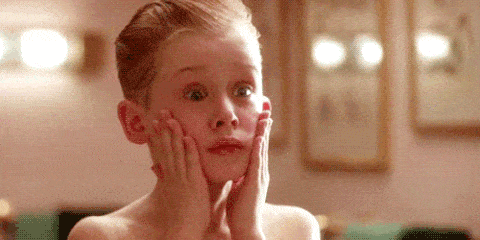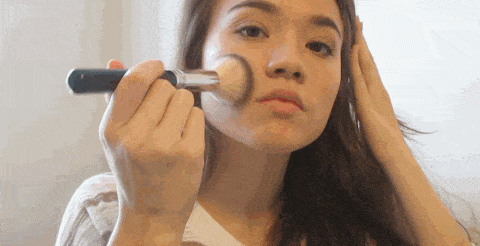7 Foundation Fails a Make-Up Artist Wants You to Stop Making
It's all about blending!

We've all been there. You're getting ready for a night out in front of a dimly-lit bedroom mirror only to leave the house and realise that your head looks like it belongs on someone else's body. And even if you do manage to perfectly colour match your foundation to your skin, there's always that age-old dilemma - do you apply it with a brush, a sponge or your fingers?!
The good news is, you don't have to waste any more time pondering the laws of foundation application. Because we've got the lowdown from SJ Froom, International Make-Up Artist for complexion experts bareMinerals, on what to avoid the next time you're reaching for the bottle.
"Always apply your foundation in daylight if possible," says SJ. "Or just find a room in your house that has good, natural lighting. Then, buy a two-sided magnifying mirror and apply your foundation using the magnifying side – this will help you with blending and getting the perfect finish."
If it's post-7pm and daylight is no longer an option, make sure you're doing your make-up in the room with the coolest lighting. "Brightly lit rooms with white cool lighting are best," says SJ. "Think bathrooms or kitchens."
Looking for fuller coverage? Slathering on that liquid goodness is not the answer. "It's all about building make-up slowly and blending all the time," says SJ. "Prep is so important, so make sure you have fully cleansed and moisturised as well as primed the skin, then gradually build your foundation on top. Apply with a brush, blending as you go, and then use your fingers to press into the skin where necessary."
And don't assume that you need full coverage everywhere, either. "Most people tend to need more on their T-zone and around the nose, eyes, forehead and chin. However, everyone is different and you may have acne or scarring on the cheeks that needs covering. I would suggest half closing your eyes and examining your face to see where you really need to apply more, or where you can leave well alone," SJ advises.
To find your skin's undertone, follow SJ's simple rules. "If your skin is warm it will have yellow tones, if it's cool it'll have pinkish tones and if it's neutral, it'll be somewhere in-between. Another way to tell if you are cool or warm is to look at the veins on the inside of your wrists - if they are blue then you have cool undertones, if they're green, you're warm and in-between, neutral."
As a general rule, opt for a foundation shade that has a slight hint of your skin's undertone, so cool undertones should look for foundations that look slightly pink in the bottle, and warm undertones should look for subtle yellow or golden-hued foundations.
This one is all about knowing your skin (and your skincare). "The most important thing to consider is skin prep," says SJ. "Your oils, correctors, serums and moisturisers all play an important part in how your foundation looks and feels."
So, if your skin is on the drier side? "If you're still after a full matte coverage, all you need to do is prep your skin with rich oils, serums and moisturisers as well as a brightening primer before applying your foundation. Then, simply highlight the areas that you want to look more dewy." Basically, you can make any formula work for you if you nail your prep. "Picking a foundation that is full of good-for-you, healthy ingredients such as bareMinerals BAREPRO liquid foundation (which also has an SPF of 20) is also a must," adds SJ.
If you need help finding the right shade, your best bet is to visit a beauty counter to get a professional shade match. "It's so important to get your colour match done professionally," says SJ. "Wearing the wrong shade or tone of foundation is a big no no. Foundation is there to make you look a more polished version of your natural self, so skin should look healthy and mimic what's underneath your make-up."
"Oh, and always ask if you can take a hand mirror outside to look at the shades in daylight," SJ advises.
No one likes a slippy foundation face. To keep your foundation in place all day long, make sure you're following the two golden rules - prime and powder.
"First, apply a primer to soak up any excess oil and smooth the appearance of the skin," SJ says. "It goes without saying that this will also help to keep your foundation in place. Finish by dusting a setting powder such as bareMinerals Mineral Veil Finishing Powder lightly over your skin. This will keep everything in staying put until you take your make-up off at the end of the day."
"Most brands will recommend the best tool for a product," says SJ. "Product development teams work on this around the clock with their team of expert artists to get the best finish. I would always recommend buying whatever the brand recommends, whether that's a sponge, brush, blender or just your fingers."
more from Beauty

#AskTheTherapist: ‘Should I break ties with my toxic sister?’

5 zodiac signs that are compatible with Pisces

9 new restaurants to hit up on your next visit to Goa

Here's what keeping the lights on can do for your sex life

#MovingOut: Amidst loneliness and piles of laundry, I grew up

Here's how vacations can make or break your relationship

Here's how to not obsess over your crush

Typsy Beauty is changing the way you think about makeup

Here’s how to tell if you’re in a rebound relationship

Everything you need to know about green auras


